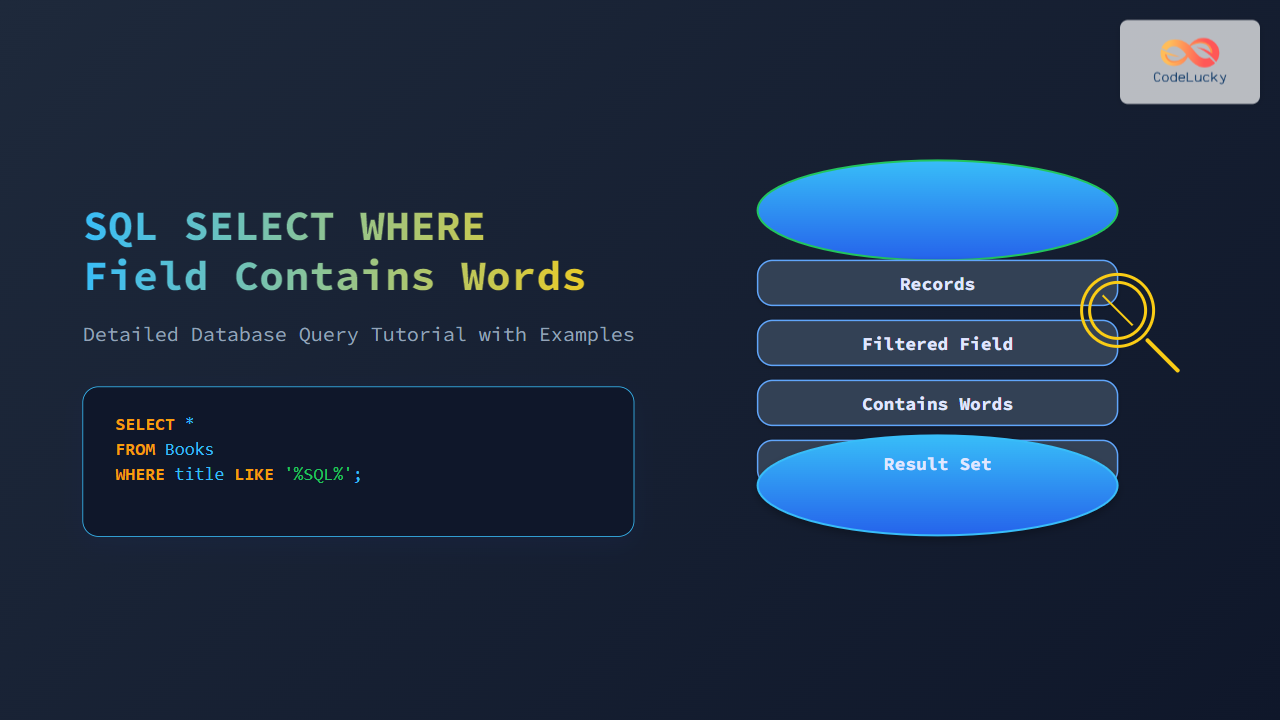SQL subqueries, also known as nested queries or inner queries, are a powerful feature that allows you to use the results of one query within another. By nesting SELECT statements, you can perform complex data retrieval and manipulation tasks that would be difficult or impossible with a single query. In this comprehensive guide, we'll explore the ins and outs of SQL subqueries, providing you with practical examples and in-depth explanations to master this essential technique.
Understanding SQL Subqueries
A subquery is a SELECT statement embedded within another SQL statement. It can be used in various parts of an SQL query, including:
- SELECT clause
- FROM clause
- WHERE clause
- HAVING clause
- INSERT, UPDATE, and DELETE statements
Subqueries are enclosed in parentheses and can return a single value, a single row, multiple rows, or even an entire table, depending on how they are constructed and used.
🔑 Key Point: Subqueries provide a way to break down complex queries into smaller, more manageable parts, making your SQL code more readable and maintainable.
Types of Subqueries
There are three main types of subqueries:
- Scalar Subqueries: Return a single value
- Row Subqueries: Return a single row with one or more columns
- Table Subqueries: Return a table with one or more rows and columns
Let's explore each type with examples.
Scalar Subqueries
Scalar subqueries return a single value and are often used in comparison operations. They can be used in SELECT, WHERE, and HAVING clauses.
Example: Let's say we have two tables, employees and departments:
CREATE TABLE employees (
employee_id INT PRIMARY KEY,
first_name VARCHAR(50),
last_name VARCHAR(50),
department_id INT,
salary DECIMAL(10, 2)
);
CREATE TABLE departments (
department_id INT PRIMARY KEY,
department_name VARCHAR(50),
manager_id INT
);
INSERT INTO employees VALUES
(1, 'John', 'Doe', 1, 50000),
(2, 'Jane', 'Smith', 2, 60000),
(3, 'Mike', 'Johnson', 1, 55000),
(4, 'Emily', 'Brown', 3, 65000);
INSERT INTO departments VALUES
(1, 'HR', 1),
(2, 'IT', 2),
(3, 'Finance', 4);
Now, let's find all employees who earn more than the average salary:
SELECT first_name, last_name, salary
FROM employees
WHERE salary > (SELECT AVG(salary) FROM employees);
Output:
first_name | last_name | salary
-----------+-----------+--------
Jane | Smith | 60000.00
Emily | Brown | 65000.00
In this example, the subquery (SELECT AVG(salary) FROM employees) calculates the average salary, which is then used in the main query's WHERE clause to filter employees.
Row Subqueries
Row subqueries return a single row with one or more columns. They are often used with row constructors or in comparison operations.
Example: Let's find the employee who manages the IT department:
SELECT first_name, last_name
FROM employees
WHERE (employee_id, department_id) = (
SELECT manager_id, department_id
FROM departments
WHERE department_name = 'IT'
);
Output:
first_name | last_name
-----------+----------
Jane | Smith
Here, the subquery returns a row containing the manager_id and department_id for the IT department. The main query then matches this row against the employees table.
Table Subqueries
Table subqueries return a table with one or more rows and columns. They are often used in the FROM clause or with IN and EXISTS operators.
Example: Let's find all employees who work in departments with more than one employee:
SELECT e.first_name, e.last_name, d.department_name
FROM employees e
JOIN departments d ON e.department_id = d.department_id
WHERE e.department_id IN (
SELECT department_id
FROM employees
GROUP BY department_id
HAVING COUNT(*) > 1
);
Output:
first_name | last_name | department_name
-----------+-----------+-----------------
John | Doe | HR
Mike | Johnson | HR
In this example, the subquery returns a table of department_ids that have more than one employee. The main query then uses this result to filter employees from those departments.
Correlated Subqueries
A correlated subquery is a subquery that depends on the outer query for its values. It's executed once for each row processed by the outer query.
Example: Let's find employees who earn more than the average salary in their department:
SELECT e1.first_name, e1.last_name, e1.salary, e1.department_id
FROM employees e1
WHERE e1.salary > (
SELECT AVG(e2.salary)
FROM employees e2
WHERE e2.department_id = e1.department_id
);
Output:
first_name | last_name | salary | department_id
-----------+-----------+----------+---------------
John | Doe | 50000.00 | 1
Jane | Smith | 60000.00 | 2
Emily | Brown | 65000.00 | 3
In this correlated subquery, the inner query calculates the average salary for each department, and the outer query compares each employee's salary to their department's average.
🔍 Pro Tip: Correlated subqueries can be powerful but may impact performance on large datasets. Consider using JOINs or window functions for better performance in some cases.
Subqueries in Different Clauses
Let's explore how subqueries can be used in various SQL clauses:
Subqueries in SELECT Clause
Subqueries in the SELECT clause are used to calculate values for each row in the result set.
Example: Let's display each employee's salary along with the difference from the average salary:
SELECT
first_name,
last_name,
salary,
salary - (SELECT AVG(salary) FROM employees) AS salary_difference
FROM employees;
Output:
first_name | last_name | salary | salary_difference
-----------+-----------+----------+-------------------
John | Doe | 50000.00 | -7500.00
Jane | Smith | 60000.00 | 2500.00
Mike | Johnson | 55000.00 | -2500.00
Emily | Brown | 65000.00 | 7500.00
Subqueries in FROM Clause
Subqueries in the FROM clause are used to create derived tables that can be queried like regular tables.
Example: Let's find the highest-paid employee in each department:
SELECT d.department_name, e.first_name, e.last_name, e.salary
FROM (
SELECT department_id, MAX(salary) AS max_salary
FROM employees
GROUP BY department_id
) AS dept_max
JOIN employees e ON e.department_id = dept_max.department_id
AND e.salary = dept_max.max_salary
JOIN departments d ON d.department_id = e.department_id;
Output:
department_name | first_name | last_name | salary
----------------+------------+-----------+--------
HR | Mike | Johnson | 55000.00
IT | Jane | Smith | 60000.00
Finance | Emily | Brown | 65000.00
Subqueries in WHERE Clause
Subqueries in the WHERE clause are used to filter rows based on a condition that involves a subquery.
Example: Let's find all employees who work in the same department as John Doe:
SELECT first_name, last_name, department_id
FROM employees
WHERE department_id = (
SELECT department_id
FROM employees
WHERE first_name = 'John' AND last_name = 'Doe'
);
Output:
first_name | last_name | department_id
-----------+-----------+---------------
John | Doe | 1
Mike | Johnson | 1
Subqueries in HAVING Clause
Subqueries in the HAVING clause are used to filter grouped results based on a condition that involves a subquery.
Example: Let's find departments where the average salary is higher than the company-wide average:
SELECT d.department_name, AVG(e.salary) AS avg_salary
FROM employees e
JOIN departments d ON e.department_id = d.department_id
GROUP BY d.department_id, d.department_name
HAVING AVG(e.salary) > (SELECT AVG(salary) FROM employees);
Output:
department_name | avg_salary
----------------+------------
IT | 60000.00
Finance | 65000.00
Advanced Subquery Techniques
EXISTS and NOT EXISTS
The EXISTS operator is used to check whether a subquery returns any rows. It's often more efficient than IN for large datasets.
Example: Let's find all departments that have at least one employee earning more than $60,000:
SELECT department_name
FROM departments d
WHERE EXISTS (
SELECT 1
FROM employees e
WHERE e.department_id = d.department_id AND e.salary > 60000
);
Output:
department_name
----------------
Finance
ALL and ANY Operators
The ALL and ANY operators are used with subqueries for comparison operations.
Example: Let's find employees who earn more than all employees in the HR department:
SELECT first_name, last_name, salary
FROM employees
WHERE salary > ALL (
SELECT salary
FROM employees e
JOIN departments d ON e.department_id = d.department_id
WHERE d.department_name = 'HR'
);
Output:
first_name | last_name | salary
-----------+-----------+--------
Jane | Smith | 60000.00
Emily | Brown | 65000.00
Subqueries in INSERT, UPDATE, and DELETE Statements
Subqueries can also be used in data manipulation statements.
Example: Let's give a 10% raise to all employees in the department with the lowest average salary:
UPDATE employees
SET salary = salary * 1.1
WHERE department_id = (
SELECT department_id
FROM employees
GROUP BY department_id
ORDER BY AVG(salary)
LIMIT 1
);
SELECT * FROM employees;
Output after update:
employee_id | first_name | last_name | department_id | salary
------------+------------+-----------+---------------+--------
1 | John | Doe | 1 | 55000.00
2 | Jane | Smith | 2 | 60000.00
3 | Mike | Johnson | 1 | 60500.00
4 | Emily | Brown | 3 | 65000.00
Best Practices and Performance Considerations
When working with subqueries, keep these best practices in mind:
- 🚀 Use indexes on columns used in subqueries to improve performance.
- 🔄 Consider using JOINs instead of correlated subqueries for better performance on large datasets.
- 📊 Use EXISTS instead of IN when checking for the existence of rows in large tables.
- 🧠 Break complex subqueries into smaller, more manageable parts for better readability and maintainability.
- 🔍 Use EXPLAIN to analyze query execution plans and optimize subqueries.
Conclusion
SQL subqueries are a powerful tool for performing complex data operations. By nesting SELECT statements, you can create sophisticated queries that filter, aggregate, and manipulate data in ways that would be difficult or impossible with simple queries. From scalar subqueries to correlated subqueries, each type has its use cases and can significantly enhance your SQL toolkit.
As you continue to work with subqueries, remember to consider performance implications, especially when dealing with large datasets. Practice writing and optimizing subqueries to become proficient in this essential SQL technique. With mastery of subqueries, you'll be well-equipped to tackle even the most challenging data analysis tasks.
Happy querying! 🎉



















